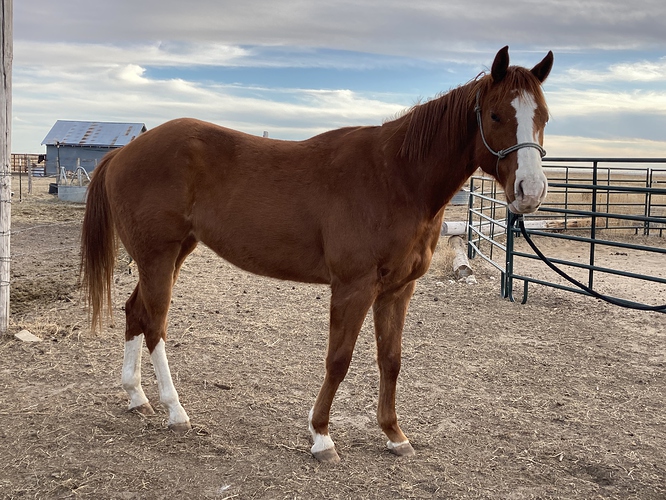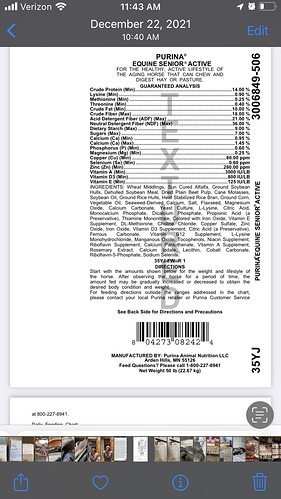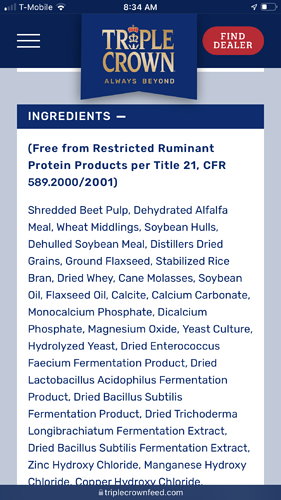I have a coming 4 yr old on purina senior active at about 6.5-7 lbs a day with 1/2 lb of triple crown 30%. He gets 24/7 access to a round bale of prairie hay. Before we pulled him in he was just on straight pasture and looked like he needed a bit of weight. He has gained some weight but is losing a little bit of muscle. I used to feed Chaffhaye but it became hard to get and I stopped using it. At that time he was on maybe 3-4 lbs of that and 1 lb of balancer and he didn’t have the fat coverage still around his ribs. I have access to purina, nutrena and triple crown from TSC. Should I just wait or try something different?
He is about 1250 lbs now. I have heard that TC is having some QC issues and they are made by purina now. Nutrena pro force fuel is very popular where I am at. He has been on this diet for about 2-3 months now.
Also I have access to Chaffhaye again
What QC issues? Every mill has some glitches.
Purina has been milling TC feeds in the East for several years now. The formulas are still controlled by TC, and with a few recent exceptions (like increase amino acid profiles to match what’s found in muscle tissue), the formulas are the same as before this milling change.
Purina Sr Active isn’t a good or bad feed. If it’s working, it’s working. If you want to feed fewer pounds/less volume, there are higher calorie and/or higher fat choices that can probably let you feed less.
You don’t NEED 1/2lb of a ration balancer with 7lb of the Sr Active. I wouldn’t feed it, either
ProForce Fuel is totally a fine feed for him. So are TC Sr, TC Complete, any of the Nutrena SafeChoice line, Purina Ultium (Competetion or Gastric care, both of which are high enough calories you can almost be guaranteed to be able to feed less, and they have a lower minimum amount anyway).
For keeping his weight up and build muscle tone out of those feeds what would you recommend?
They also said the senior active is 1600 kcal per lb
TBH you just have to try and see how a give feed works. At his age, kind of anything goes - he’s not growing from a nutritional perspective, so nutrition is really based on being an adult. Lots of adults do well on a Sr feed.
Ok I will give it a couple more months and if he doesn’t build the muscle that he needs on his topline around his withers, which is where he needs it most I’ll go with the performance feed like ultium gastric care. That was my other choice when I was originally looking because I want gut support for him.
you can’t spot-build muscle (or spot-lose fat)
The most common causes of muscle not building around the withers is saddle fit, and conformation.
Why are you feeding a senior feed? Are you feeding the minimum req pounds/day (or more?) Personally, I am feeding Purina Strategy Pro GX, and my guys do well on it.
She’s feeding “6.5-7 lbs a day with 1/2 lb of triple crown 30%”
She’s also feeding well in the recommended amounts
If he is having trouble building muscle but not keeping weight, I would do a ration balancer and add in purina super sport or a similar product.
If he is both low in muscle and needs weight, I’d move to ultium or the TC equivalent.
I may start an internet argument here, but senior feeds aren’t a very useful feed for most horses IMO. You always want to try to feed the least amount of grain possible to prevent health issues. So you either want to move to a ration balancer (for easier keepers) since only 1-2 pounds is necessary, or move to the highest calorie and fat feed you can purchase (for medium to hard keepers) so that you can feed the least amount of grain possible.
Here is the start of the ingredients list for Triple Crown Senior Gold. As you can see the first two ingredients are BP and alfalfa. Hardly grain heavy.
With a feed rate of 6 lbs vs Ultium at 4.5 to 5 lbs and the lower NSC value of TCS Gold… hardly more grain feeding the Senior.
Just some quick general thoughts. Looks like you’re located out west? From the pictures, looks like western plains, and you mention prairie hay. I’m in the western plains and used to feed a prairie hay. I got it on trade for use of land by the guy who runs cattle in the area. I knew the hay wasn’t great but I thought I could out-supplement it.
It seemed that I had extremely hard keepers, terrible toplines, etc. I tried both TC and ADM feeds; both very expensive in my area and high end formulas. I could hardly keep up with the cost of grain and the horses just looked blah.
I changed to straight alfalfa and suddenly I no longer had hard keepers, and their toplines had the nutritional support to build where they could; most are broodmares, so not in work but on full turnout and get plenty of natural work over the topline. Most of my horses are now on just a ration balancer and don’t need the additional calories or topline fixers. And those who do need a bit of concentrate are able to maintain on SafeChoice.
So, long story long, you cannot out-feed an average or poor quality hay (not judging your hay since there is no analysis) with the highest of quality concentrates. But an excellent quality hay can be complemented with an average quality maintenance-type concentrate in most cases.
CYA, your situation and horse’s needs may be totally different. Some feeds work great for some, but not for others. TC is a great quality feed, but it is not a miracle worker if the hay quality isn’t there.
A lot of grains use BP or Alfalfa as a base, but it’s all the other ‘stuff’ that can cause issues (ulcers). The difference between 4.5 and 6 pounds doesn’t seem like much, but it can make a huge difference if you have a horse that’s ulcer prone. And in the recent years, it’s starting to look like every horse is ulcer prone; it’s just that some don’t show pain. It’s best to feed as little grain as possible.
If you need to add bulk to your horses meal, hay pellets are always a good thing to add.
So many other things contribute to ulcers though - like stalling horses rather than letting them walk/graze/browse 24/7. It’s not senior feed versus hay pellets.
There is nothing wrong with feeding a commercial concentrate. For a lot of horses, it makes a very big difference because of the concentrated calories. That said, many horses need very little. It’s really finding what works for each particular horse.
I have a senior TB that eats a full ration of Nutrena Senior feed every day, and two late teens who get the minimum ration of the Nutrena Special Care. None are in work, all out 24/7 with free access to hay. One size does not fit all.
I was under the impression that it was the sugar/starch/carbs in the grain that was the ulcer risk.
I think we have the same goal, use as little grain as possible, but have differing understandings as to what that means in a practical application.
I’m not anti-grain; I feed all of my horses grain of some sort. But even feed companies will tell you to feed as little grain as possible to achieve the results you want. If you have a hard keeper, it is healthier for them to receive 4 pounds of grain a day vs 6 or 8. Pretty much any feed company or vet will agree with that statement.
So if you have easy keepers, it’s better to feed them one or two pounds of a ration balancer than 3-4 pounds of grain (since you’d need to do so in order to get them their vitamins and minerals).
And if you have a hard keeper, it’s best to feed the highest calorie and fat feed you can find, so you can feed the least amount of it.





